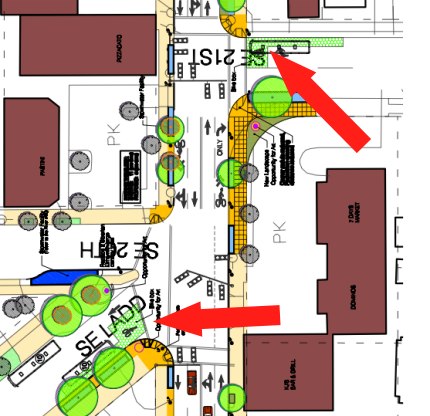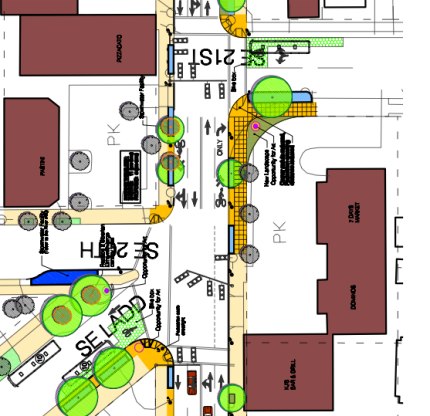Portland City Council officially adopted the Bureau of Transportation’s Division Streetscape and Street Reconstruction Project yesterday.

The plan was over a year in the making and it will impact the stretch of SE Division between SE 10th and 39th Avenues. The $7 million project will repave the street, add a full complement of “green streetscape elements” (like bioswales and curb extensions), improve transit stops, and more. Construction is slated to begin in 2011.
“… we feel that there is a significant lost opportunity at 7 Corners… the concept does not significantly foster a sense of place or create the comfortable pedestrian environment the community desires.”
— Excerpt from a letter by the project’s Citizens Advisory Committee
Of particular interest to those of us who ride a bike in this area how changes to the lane configuration on Division might impact bike boulevards and new bike boxes coming to the Seven Corners intersection (where SE Ladd crosses Division to SE 21st).
Currently, Division is a four-lane, high-volume (15,000 cars per day) thoroughfare, but PBOT allows on-street parking in the outside lanes between SE 11th and SE 28th during all but two hours in the morning (7-9am) and evening (4-6pm) rush (this arrangement is known as “pro-time lanes”). These outside lanes aren’t usually full of parked cars, so people on bikes sometimes use them and they provide extra capacity for motor vehicle traffic.
Under the new plan, PBOT will get rid of the “pro time lanes” and will reduce Division to two travel lanes (and two permanent parking lanes). Four travel lanes will be maintained at SE 11/12th, Seven Corners and SE 26th to “provide capacity during peak travel times.”
The Citizens Advisory Committee had hoped PBOT would consider reducing Division to two travel lanes at Seven Corners (which they feel is the heart of their community) in order to create a “sense of place” and a “buffer from traffic” and use the space instead to built wider sidewalks or bike lanes. PBOT decided against that idea, citing “complexity of the intersection and the high daily traffic volumes”. Here’s more from the project document.
“The City’s analysis indicated that given present and future predicted travel patterns, narrowing the Seven Corners intersection to a two-lane profile could result in significant congestion Division Street and diversion of vehicles into the adjacent neighborhood.”
In a letter, the project’s Citizens Advisory Committee expressed their disappointment with that decision:
“… we feel that there is a significant lost opportunity at 7 Corners. Though nothing in the concept precludes 7 Corners from eventually becoming a significant gathering place for the community, the concept does not significantly foster a sense of place or create the comfortable pedestrian environment the community desires.”
As PBOT suggests, the removal of travel lanes on Division could result in more cars using side streets. This issue raised significant concerns from nearby residents as well as the Bicycle Transportation Alliance and members of the City’s Bicycle Advisory Committee who are worried about diversion onto the nearby Clinton Street and Ladd/Harrison bike boulevards.
As early as January 2010, the BAC asked PBOT project manager Elizabeth Mahon to look closely at the diversion issue. At their January meeting, PBOT bike coordinator Roger Geller asked Mahon to adopt a policy in the plan that would commit the city to taking action if diversion onto Clinton occurred. Geller noted that there’s already more motor vehicle traffic on Clinton that they’d prefer. “We already want to do something on Clinton because the auto volumes are too high,” he said.
Again in February, the BTA’s Michelle Poyourow (who has since left the organization) asked PBOT to make diversion analysis an official part of the plan. Then in April (this is all according to my notes taken from BAC meetings), the issue came up again, with the BAC still concerned that PBOT was being too vague about their plans to address the diversion issue.
Looking at the project plan adopted yesterday, it seems their concerns were ultimately heard. On page 16 of the plan is a “Diversion Statement” that acknowledges the Clinton Street Bike Boulevard as being a “vibrant and well-established bicycle facility” and an “important east/west connection” for bike traffic.
Heeding concerns that changes to traffic on Division could “negatively impact a popular bicycle route,” PBOT has officially agreed to (in their words):
- monitor traffic volumes on Division Street and Clinton Street (SE 12th to 39th)
- mitigate for any diversion of autos from Division Street onto Clinton (SE 12th to 39th) as a direct result of the project
- PBOT will conduct a series of before and after counts on both Division Street and Clinton Street. The counts will be taken during the same time period (week and month) and under similar weather conditions. Counts will also be conducted when the local schools are in session.
The plan says that if PBOT determines that diversion has occurred “staff will take measures to prevent any further diversion” and will work with the community to examine additional traffic calming measures on Clinton.
The other piece of this project that will impact bike traffic are two new bike boxes coming to the Seven Corners intersection where SE Ladd crosses Division to get to SE 21st. Ladd is a very busy bike route that connects SE Hawthorne to the Clinton Street bike boulevard. Below is a plan drawing of how the Division Streetscrape Project will change this intersection (note the two bike boxes and two sharrows (on Division)):

PBOT also cites more painted crosswalks and curb extensions on Division as “bicycle amenities” in the project. In addition to the crossing at SE Ladd/21st, the other two City bike routes that cross Division are at SE 26th and SE 34th. Neither of those crossings will receive new crosswalks or curb extensions.
In their adopted plan, PBOT refers to the bike-specific aspects of this plan as “amenities” and puts them in a chapter devoted to “design elements” which also includes information on public art and street lighting. As criteria for improvements to the street, PBOT lists “Vehicle Operations: Maintain adequate vehicle and truck access to local businesses and residences” and then has a separate criteria for “bike accessibility.”
It’s interesting to note that, according to PBOT counts (taken during summer), the number of people biking on SE Lincoln/Harrison, Clinton, and Ladd is greater than the number of people driving cars.
In September 2009, I reported that PBOT would install sharrows in the outside lanes on Division at Seven Corners but that idea did not survive. UPDATE: Sharrows are still in the plan but were left out of the report passed by Council. Project manager Liz Mahon says she will revise the report and make sure they are included in the final draft. The sharrows will be placed on SE Division between SE 21st and SE Ladd.
Given PBOT’s perspective on bicycle traffic in this plan and the reason they cited for not creating more space for people at Seven Corners, it’s obvious that the flow of motor vehicle traffic had the highest priority in designing this plan.
I ask folks to consider this: Will the City of Portland ever be able to reach its climate and active transportation goals if we continue to plan large projects around the primacy of motor vehicle traffic?

